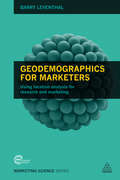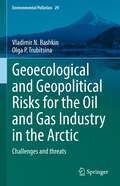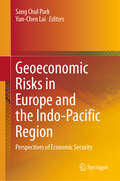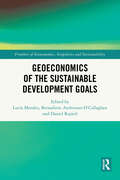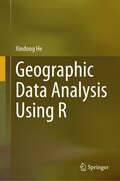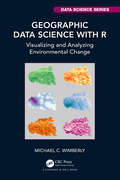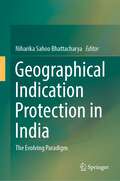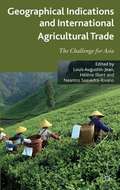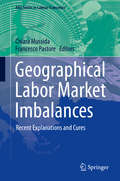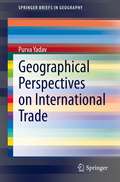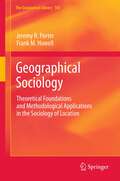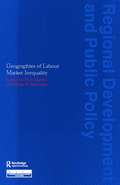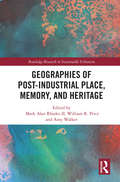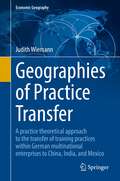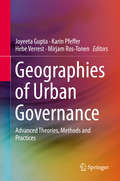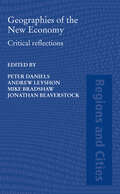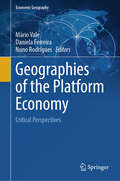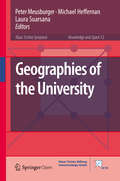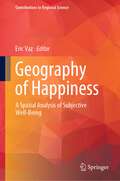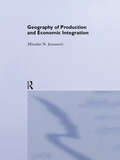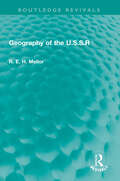- Table View
- List View
Geodemographics for Marketers
by Barry LeventhalGeodemographics, the process of analyzing survey data to profile economic and demographic characteristics of populations, is a successful data-driven analysis tool for marketers. Geodemographic classifications are widely embedded in customer databases and market research datasets. Written by a leading UK authority on geodemographics, Geodemographics for Marketers provides marketers with the know-how to leverage it as an effective research tool to identify location-based segments for highly targeted marketing. International in scope and impartial in its approach, this book demonstrates how to implement geodemographics techniques for practical application in retail, financial services and telecommunications as well as the public sector. Geodemographics for Marketers includes numerous case studies, from the automotive, retail and telecommunications sectors to the public sector, that illustrate core concepts and how they can be applied to gain positive results. The book also incorporates the newly introduced generation of classifications, as well as a discussion of the key decisions of the proposed 2021 census.
Geoecological and Geopolitical Risks for the Oil and Gas Industry in the Arctic: Challenges and threats (Environmental Pollution #29)
by Vladimir N. Bashkin Olga Р. TrubitsinaThis book discusses issues of geoecological (GER) and geopolitical (GPR) risks due to hydrocarbon development of the Arctic. The authors explain the ethical and philosophical foundations of understanding environmental equity and justice in relation to the development of Arctic natural resources and consider various approaches to the moral aspects of making global management decisions in the field of environmental protection and environmental safety. Special attention is paid to analysis of modern geopolitical and geostrategic challenges to the development of the Arctic region. The monograph identifies the key geopolitical factors affecting the sustainable development of the Arctic and analyzes the similarities and differences in the geostrategic positions of the five Arctic states. The authors reveal the need to consider geopolitical challenges in the process of GER analysis for oil and gas development in the Arctic region. The book explores the intersection of the strategic interests for a number of states and describes Russia's inability to ensure environmental safety in the development of Arctic deposits. The book analyzes in detail each type of GER with an emphasis on their potential to lead to additional opportunities and threats, and assesses environmental rating as an indicator of the GER management process of Russian oil and gas companies operating in the Arctic. Although the main focus is on the Russian part of this region, many arguments and conclusions are quite applicable to the entire Arctic region. The consideration of geoecological and geopolitical aspects of the development of Arctic resources with the example of Russian oil and gas companies sheds light on the entire Arctic region, taking into account the interests of all other national and international companies involved in GER and GPR there.
Geoeconomic Risks in Europe and the Indo-Pacific Region: Perspectives of Economic Security
by Sang Chul Park Yun-Chen LaiThis book explores the evolving landscape of global political economy amidst a shifting global order, ushered in by the impacts of the COVID-19 pandemic, geopolitical conflicts in Ukraine and Gaza, and rising trade and political disputes between the US, China and the EU, leading to a rise in protectionist policies and disruptions in global supply chains leading to high inflation, and energy and food crises. Focusing on the relations between the European Union and the Indo-Pacific region, this book examines how recent protectionist policies are reshaping economic security and cooperation between the two actors.
Geoeconomics of the Sustainable Development Goals (Frontiers of Geoeconomics, Geopolitics and Sustainability)
by Bernadette Andreosso-O’Callaghan Lucía Morales Daniel RajmilIn 2015, the United Nations introduced its very ambitious 2030 Agenda, known as the Sustainable Developmental Goals or SDGs. The SDGs provide a comprehensive list of goals and targets to address social, economic and environmental issues. In this book, different areas of expertise are brought together, examining the main challenges associated with the effects of “climate change” and the broader scope of the SDGs through the lenses of the geo-economics and geopolitics of sustainability. The book sheds light on the growing connections between the economic and financial fields and their impact on defining the international order and its economy. It examines the importance of trade and economic integration in promoting sustainable development and achieving the SDGs.The role of supranational organisations like the United Nations, the World Trade Organisation and the IMF in supporting the SDGs within the context of the world’s most advanced economies and those less developed; the influence of economic diplomacy and geopolitical rivalries on progress towards the SDGs; the changing global balance of power and the significance of technology and innovation; as well as the role of emerging and less developed economies in enabling sustainable development. The book offers insights into practical issues linked to theory and applied frameworks, underscoring the significant challenges associated with sustainable development, the global economic and political reality, and how political tensions affect the global economy.The book supports students through the established disciplines of economics, finance, political science, and law and provides academics with new research and theory-building tools.
Geographic Data Analysis Using R
by Xindong HeThis book is structured to encompass both the foundational and specialized aspects of quantitative analysis in geography. The basic content covers descriptive statistical analysis and correlation analysis of geographical data, while the professional content delves into more advanced topics like linear regression analysis, geographically weighted regression analysis, time series analysis, cluster analysis, principal component analysis, Markov chain analysis, and geographical network analysis. The methodologies span from widely utilized techniques to more recent developments, and the data primarily originates from reputable sources in China. The example code provided in the book can be executed using R packages available on the CRAN website.This book is an invaluable resource for undergraduate and graduate students, as well as researchers interested in learning and applying R for processing, visualizing, and analyzing geographic data. It serves as an introductory course in quantitative methods in geography for students in geography departments. Additionally, it is an ideal supplementary text for applied methods courses across various disciplines that involve geographic data, such as human and physical geography, geographic information science, ecology, public health, crime, and economics.
Geographic Data Science with R: Visualizing and Analyzing Environmental Change (Chapman & Hall/CRC Data Science Series)
by Michael C. WimberlyThe burgeoning field of data science has provided a wealth of techniques for analysing large and complex geospatial datasets, including descriptive, explanatory, and predictive analytics. However, applying these methods is just one part of the overall process of geographic data science. Other critical steps include screening for suspect data values, handling missing data, harmonizing data from multiple sources, summarizing the data, and visualizing data and analysis results. Although there are many books available on statistical and machine learning methods, few encompass the broader topic of scientific workflows for geospatial data processing and analysis. The purpose of Geographic Data Science with R is to fill this gap by providing a series of tutorials aimed at teaching good practices for using geospatial data to address problems in environmental geography. It is based on the R language and environment, which currently provides the best option for working with diverse spatial and non-spatial data in a single platform. Fundamental techniques for processing and visualizing tabular, vector, and raster data are introduced through a series of practical examples followed by case studies that combine multiple types of data to address more complex problems. The book will have a broad audience. Both students and professionals can use it as a workbook to learn high-level techniques for geospatial data processing and analysis with R. It is also suitable as a textbook. Although not intended to provide a comprehensive introduction to R, it is designed to be accessible to readers who have at least some knowledge of coding but little to no experience with R. Key Features: Focus on developing practical workflows for processing and integrating multiple sources of geospatial data in R Example-based approach that teaches R programming and data science concepts through real-world applications related to climate, land cover and land use, and natural hazards. Consistent use of tidyverse packages for tabular data manipulation and visualization. Strong focus on analysing continuous and categorical raster datasets using the new terra package Organized so that each chapter builds on the topics and techniques covered in the preceding chapters Can be used for self-study or as the textbook for a geospatial science course.
Geographical Indication Protection in India: The Evolving Paradigm
by Niharika Sahoo BhattacharyaThis book is a unique compilation of comprehensive works covering the potentials, challenges, and realities of geographical indications from an Indian perspective. The book encompasses critical studies on legal, regulatory, and institutional frameworks and debates surrounding geographical indications. The concept of geographical indication has not received paramount importance in India compared to the other forms of intellectual property rights like patents and trademarks, while GI is becoming critical in national and international discourses. It aims at presenting both national and international situations and discussions, which will appeal to readers worldwide. This book in its first part elaborately deals with the genesis of the GI Act, and then it goes on to analyze both substantive as well as procedural aspects of the registration under the Indian GI Act and tries to identify the discrepancy and gaps in the laws. Also, a comparative perspective has been built by analyzing the GI laws and regulations of some developed countries with that of India. The challenges in existing regulation for quality control and enforcement of GI products in the Indian GI Act have been dealt comprehensively by the authors which are critical in achieving the stated objectives of the Act.The book also focuses on the role of geographical indication in the socio-economic development of rural India. The authors have illustrated how the GI can act as an effective mechanism for employment generation and sustainable growth opportunities in different sectors like agriculture, food, and handicraft. The interaction of GI with traditional knowledge and biodiversity and their impact on society is also extensively covered. The book contains real-life case studies by the authors from different states of India highlighting the success stories and missed opportunities of different GIs and the way forward where the GI can function as an effective tool for the overall development of a country and promote international trade. The book will provide law students, scholars from legal and IP disciplines, legal practitioners, producers, and policymakers a factual and multidimensional insight into the GI system in India. This will further promote research in this area, particularly from an Asian perspective and enhance the real-life application of GI to varied products.
Geographical Indications and International Agricultural Trade
by Louis Augustin-Jean Hélène Ilbert Neantro Saavedra-RivanoFood safety concerns have boosted the Asian demand for quality food in general and products of geographical indications in particular. This book shows how Asian countries are empowering regions and enterprises involved in differentiation strategies, and the effects that this regulation can have.
Geographical Labor Market Imbalances
by Francesco Pastore Chiara MussidaThis book focuses on the questions of how territorial differences in productivity levels and unemployment rates arise in the first place and why territorial differences in labor market performance persist over time. Unemployment divergence and unemployment club convergence have been touched on in a large number of works and have recently also been studied using spatial econometric analysis. In this book we aim to develop the debate to include several important new topics, such as: the reasons why structural changes in some sectors cause slumps in some regions but not in others; the extent to which agglomeration factors explain regional imbalances; the degree of convergence / divergence across EU countries and regions; the role of labor mobility in reducing / increasing regional labor market imbalances; the impact of EU and country-level regional policy in stimulating convergence and the (unsatisfactory) role of active labor market policy in stimulating labor supply in the weakest economic areas.
Geographical Perspectives on International Trade (SpringerBriefs in Geography)
by Purva YadavThis book analyzes spatial and temporal patterns of international trade from a geographical perspective. Trade is an important key to understanding the changing dynamics of economic spaces over time. However, studies by geographers are largely confined to case studies, whereas the spatial dimension is often missing from the approach of economists. This study highlights spatial patterns and commodity composition of global trade and the nature of relationship between trade and other economic attributes. A case study of the MERCOSUR trade block examines inter-regional and intra-regional trade flows. The book captures a comprehensive picture of the structure of international exchange by using ample maps and illustrations as supporting features. Many different methods are applied such as the location quotient to capture concentration and diversification of commodity composition, data reduction techniques such as factor analysis and regression models for relating the economic structures and trade patterns as well as residual mapping among others. This book is a significant contribution to geographical, economical and social sciences research and very useful to graduate and post-graduate students as well as scientists of all related areas who have interest in exploring the changing dynamics of the global economy via trade flows. It provides a road map to further explore different dimensions of international trade and its role in understanding the transforming global economy.
Geographical Scale and Economic Development: Lessons Learned from Texas and Mexico
by Michael S. YoderThis book is an attempt to bridge the academic discipline of economic geography with the professional field of economic development. Through case studies of economic development, it illustrates two fundamental concepts of the sub-discipline of economic geography: scale and spatial connections. It demonstrates some of the ways that economic development policies and plans are linked globally, nationally, regionally, and locally. It ties together several studies of communities and transportation systems in Texas and Mexico carried out from the late 2010’s through 2021. The studies shed light on the need to study economic development at multiple scales and to do so through blended qualitative research methods that include conversations with economic development stakeholders, published data, news content from the business and trade media, and direct observation of the built environment.The book is a set of narratives that combine descriptions of the evolution of commercial transportation systems, economic promotion in selected communities, and corresponding changes in the built environment. It is organized into three sections, each of which corresponds to a different scale at which economic development functions: macro, regional, and local.
Geographical Sociology: Theoretical Foundations and Methodological Applications in the Sociology of Location
by Frank M. Howell Jeremy R. PorterThe discipline of Sociology has a rich history of including spatial context in the analysis of social issues. Much of this history has revolved around the development and application of spatial theory aimed at understanding the geographic distribution of social problems, the organization of communities, and the relationship between society and the environment. More recently, the social sciences have seen a large number of technological innovations that now make it possible to place social behaviour in spatial context. Consequently, because of the historical disjuncture in the development of spatial theory and the recent development of relevant methodological tools, the relationship between materials describing both the methodological approaches and their theoretical importance a scattered throughout various books and articles. Geographical Sociology consolidates these materials into a single accessible source in which spatial concepts such as containment, proximity, adjacency, and others are examined in relation to such methodological tools as hierarchical linear models, point pattern analysis, and spatial regression. As these methods continue to increase in popularity among social scientists the ability to more generally understand societies relationship to geographic space will continue to increase in it importance in the field. This book represents a starting point to linking these concepts to practice and is presented in an accessible form in which students, researchers, and educators can all learn, and in turn, contribute to its development.
Geographically Embedded World Economic Hubs: Enduring Growth Across Four Major Bay Areas
by Yongnian Zheng Dongni HeThis book develops the concept and theory of geographically embedded world economic hubs through a comparative analysis of developmental strengths of the four major bay areas in the world — the San Francisco Bay Area, the New York Bay Area, the Tokyo Bay Area, and the Guangdong-Hong Kong-Macao Greater Bay Area. The book discusses the outstanding socioeconomic features of these regions from the perspectives of sci-tech innovation, government-enterprise relations, talent cultivation, and financial market development and examines the embeddedness of innovation factors and resources in these four major bay areas. Such embeddedness emerges from the three open systems of science, education, and talent; enterprise; and finance. The book draws policy implications for cities and regions that seek value-added growth and transformation.
Geographies of Labour Market Inequality (Regions and Cities)
by Ron Martin Philip S. MorrisonIn recent years, the local dimensions of the labour market have attracted increasing attention from academic analysts and public policy-makers alike. There is growing realization that there is no such thing as the national labour market, instead a mosaic of local and regional markets that differ in nature, performance and regulation. Geographies of Labour Market Inequality is concerned with these multiple geographies of employment, unemployment, work and incomes, and their implications for public policy.
Geographies of Post-Industrial Place, Memory, and Heritage (Routledge Research in Sustainable Urbanism)
by Amy Walker Mark Alan Rhodes II William R. PriceAll industrialization is deeply rooted within the specific geographies in which it took place, and echoes of previous industrialization continue to reverberate in these places through to the modern day. This book investigates the overlap of memory and the impacts of industrialization within today’s communities and the senses of place and heritage that grew alongside and in reaction to the growth of mines, mills, and factories. The economic and social change that accompanied the unchecked accumulation of wealth and exploitation of labor as the industrial revolution spread throughout the world has numerous lasting impacts on the socioeconomics of today. Likewise, the planet itself is now reeling. The memory and heritage of these processes reach into the communities that owe the industrial revolution their existence, but these populations also often suffered adverse impacts to their health and environment through the large-scale and rapid extraction of natural resources and production of goods. Through the themes of memory, community, and place; working post-industrial landscapes; and the de-romanticization of industrial pasts, this book examines the endurance and decline of these communities, the spatial processes of industrial byproducts, and the memory and heritage of industrialization and its legacies. While based in the traditions of geography, this collection also draws upon and will be of great interest to students and scholars of cultural anthropology, archaeology, sociology, history, architecture, civil engineering, and heritage, memory, museum, and tourism studies. Using global examples, the authors provide a uniquely geographic understanding to industrial heritage across the spaces, places, and memories of industrial development.
Geographies of Practice Transfer: A practice theoretical approach to the transfer of training practices within German multinational enterprises to China, India, and Mexico (Economic Geography)
by Judith WiemannEmploying a practice theoretical approach, this study centers on how German multinational enterprises transfer three selected production-related training practices to their subsidiaries in emerging economies: onboarding of new employees, shop floor inducting of machine operators, and German-style dual apprenticeship training for specialized technicians. Empirical findings are drawn from three research regions: Greater Shanghai Area (China), Metropolitan Areas Mumbai-Pune-Bangalore (India), and Central Mexico (Mexico).In doing so, this study contributes to debates about the internationalization of multinational enterprises conceptualizing internationalization through the lens of practice transfer. Practice transfer is still an understudied phenomenon in economic geography while international business studies have a long-standing research interest in this area. This study provides a bridge between these two disciplinary fields connecting debates in economic geography on proximity/distance and knowledge transfer with organization studies-based research in international business studies – all the while providing a unique new perspective by developing a practice theoretical approach to explain practice transfer across distance and between territories.
Geographies of Urban Governance
by Joyeeta Gupta Mirjam Ros-Tonen Karin Pfeffer Hebe VerrestWith a current population inflow into cities of 200,000 people per day, UN Habitat expects that up to 75% of the global population will live in cities by 2050. Influenced by forces of globalization and global change, cities and urban life are transforming rapidly, impacting human welfare, economic development and urban-regional landscapes. This poses new challenges to urban governance, while emerging city networks, advancing geo-technologies and increasing production of continuous data streams require governance actors to re-think and re-work conventional work processes and practices. This book has been written to enhance our understanding of how governance can contribute to the development of just and resilient cities in a context of rapid urban transformations. It examines current governance patterns from a geographical and inclusive development perspective, emphasizing the importance of place, space, scale and human-environment interactions, and paying attention to contemporary processes of participation, networking, and spatialized digitization. The challenge we are facing is to turn future cities into inclusive cities that are diverse but just and within their ecological limits. We believe that the state-of-the-art overview of topical discussions on governance theories, instruments, methods and practices presented in this book provides a basis for understanding and analyzing these challenges.
Geographies of the New Economy: Critical Reflections (Regions and Cities)
by Andrew Leyshon Jonathan Beaverstock Peter W. Daniels Michael J. BradshawWhat is the 'new economy'? Where is it? How does it differ from the 'old economy'? How does the 'new economy' relate to issues such as the nature of work, social inclusion and exclusion? Geographies of the New Economy explores the meaning of the 'new economy' at the global scale from the perspective of advanced post-socialist and emerging economies. Drawing on evidence from regions around the world, the book debates the efficacy of the widely used concept of the ‘new economy’ and examines its socio-spatial consequences. This book is important reading for policy-makers, academics and students of geography, sociology, urban studies, economics, planning and policy studies.
Geographies of the Platform Economy: Critical Perspectives (Economic Geography)
by Mário Vale Daniela Ferreira Nuno RodriguesThis book provides a wider understanding of the geographies of the platform economy, focusing on the critical perspectives that have emerged on this new economic and digital context. Technological development, particularly the emergence of big data in combination with platforms, additive manufacturing, advanced robotics, machine learning and the internet of things, has created conditions for the appearance of a new economic context predominantly based on new forms of services. This new economic context has been described as the platform economy or platform capitalism. Other designations have also appeared to describe particular consequences of this new phenomena, such as the gig economy or the sharing economy.There is a significant diversity of scientific fields that are studying topics related to the platform economy. Several studies have emerged from different fields, including, but not limited to, geography, economy, sociology, information science, management, marketing, or the humanities. However, geography has become an important field to understand the platform economy given its critical position over the economic, cultural, and social issues that stem from this new economic context. The purpose of this book is to approach these discussions and offer a critical view of the platform economy from the perspective of geography, stemming from the different subfields of the discipline and not restricted to what has been referred to as Digital Geography.This book will appeal to scholars, undergraduate and postgraduate students in the social sciences. It will be particularly relevant to those with research interests in digital geographies and economic geography, economics and business.
Geographies of the University (Knowledge and Space #12)
by Michael Heffernan Peter Meusburger Laura SuarsanaThis open access volume raises awareness of the histories, geographies, and practices of universities and analyzes their role as key actors in today’s global knowledge economy. Universities are centers of research, teaching, and expertise with significant economic, social, and cultural impacts at different geographical scales. Scholars from a variety of disciplines and countries offer original analyses and discussions along five main themes: historical perspectives on the university as a site of knowledge production, cultural encounter, and political interest; institutional perspectives on university governance and the creation of innovative environments; relationships between universities and the city; the impact of universities on national and regional economies and cultures; and the processes of internationalization through student mobility, the creation of education hubs, and global regionalism in higher education.
Geography and Tourism Marketing
by Kaye Sung ChonTourism is an extremely challenging business. Some strategies work phenomenally well sometimes and fail at others. You may be aware of the increased fragmentation of the consumer market and of the important role geography plays in tourist response but have difficulty finding a pattern to this without doing a lot of research. Geography and Tourism Marketing will provide you with diverse studies through which you will gain a better understanding of what excites and entices all types of consumers along with new strategies in your field to keep you up-to-date in the unpredictable business of tourism.Geography and Tourism Marketing is a compilation of greatly varied and valuable case studies and articles. In it you’ll explore thought-provoking topics such as these: the World Wide Web as one of the most significant technological developments in travel and tourism marketing the advantages of understanding the impact that a tourist’s country of origin has on small island destinations pinpointing problems in a specific business venture so you can avoid similar mistakes providing interactive maps to potential consumers through Geographic Information Systems determining the effectiveness of brochures reformulating and promoting a consistent image of a destination in order to better serve consumers the fast-growing market of nature travelers and how they can be targeted more effectivelyIn this book, you will get current information on the link between geography and tourism marketing, which is an important aspect in conquering market segmentation and improving tourism marketing approaches. You will see the necessity of acknowledging this connection and be prepared to respond to it when you read Geography and Tourism Marketing.
Geography of Competition and Strategy
by Michael J. EnrightAddresses the role of geographic scope in competition and strategy. Makes distinctions between the geographic scope of competition (or the effective area over which firms compete), the geographic scope of competitive advantage (or the geographic area from which a firm can draw locational advantages), and the geographic scope of strategy (the area over which a firm chooses to compete and locate its activities). The geographic scope of competition is influenced by technology, tastes, governments, and company strategy. Locational advantages are the result of favorable factor conditions, demand conditions, related and supporting industries, firm strategy, structure, and rivalry. The firm may choose to compete in a single market (a geographically focused strategy), in all markets (a global strategy), or some combination of markets. The firm can choose the configuration (location) and coordination of its activities. The firm adds value to geographically dispersed units through the choice of markets to serve, the location and coordination of activities, and the active management of economies of scale, scope, and learning.
Geography of Happiness: A Spatial Analysis of Subjective Well-Being (Contributions to Regional Science)
by Eric VazThis book offers readers a spatial understanding of happiness and subjective well-being. By integrating spatial and geostatistical methods, it sheds new light on the spatial and geographical aspects of subjective well-being. Geographical analysis allows us to measure spatial and regional discrepancies in subjective well-being and to identify heterogeneous profiles in terms of social, economic and environmental patterns. Consequently, the papers gathered here address various topics concerning the spatial aspects of subjective well-being, including social injustice, age, new urban spaces, and tourism. The book proposes a multidisciplinary approach and is intended for scholars and students in the fields of geography, economics and the spatial sciences. By examining several critical dimensions of happiness and subjective well-being, it enriches the complexity of regional decision-making on the path toward happier and more liveable societies.
Geography of Production and Economic Integration (Routledge Studies in the Modern World Economy)
by Miroslav JovanovicThis book discusses the way in which economic integration and preferential trade agreements reinforce or alter the existing location of industries. Using a conceptual approach with real life examples, the author seeks to clarify and explain the key tendencies of the relationship and influence between spatial distribution of production and economic integration. Geography of Production and Economic Integration will develop students', specialists' and policymakers' understanding of this highly topical subject.
Geography of the U.S.S.R (Routledge Revivals)
by R. E. MellorOriginally published in 1964, and extensively illustrated with figures and charts, this volume gives an overview of both physical and human geography of the former USSR. The role that the geography of the country has played in shaping historical events and political forces is discussed, as is its role in the economy of the Soviet Union. The geography is examined by topics and regional differences explained within this framework. The book looks at some of the major problems posed by geographical conditions and how they have been tackled and as far as data allows, the success or failure of measures has been assessed.
